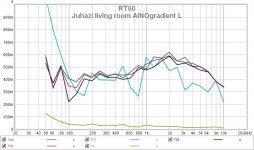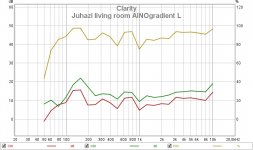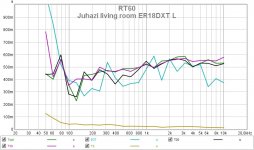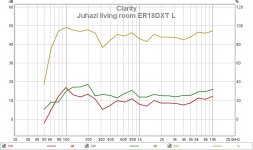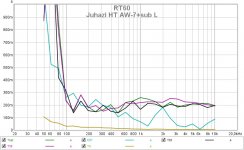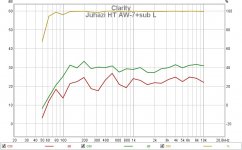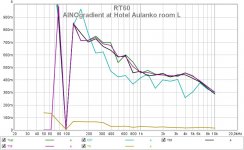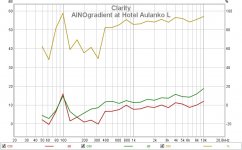Yes all treatment in this case was on the walls. The floor was thick Berber carpet on a thick pad. The ceiling was wood, and at 3.3 meters. I dabbled a little with ceiling treatments, but never found what I wanted. The Altec horns didn't hit the ceiling too much. I was lucky to have a little extra height and the wood. Ceilings can be a big problem.
I also have Altec (actually UREI) in zero treated low ceiling room, and the horn really helps in that room.
I had to cover all of my wooded structure of the garage with layers of sheetrock and 8" thick cloud of OC703 for sound proofing and absorption, but I think higher uncovered wooden ceiling would be more musically correct. I have diffusers at the ear level on both side between listening point and speakers, and it is working as it should be.
One of the comments I made was "...this is already paying off...". What I was referring to was the systemic rise in T30 values above 1 kHz for the untreated cases that I see in the couple of room reverberation time plots (T20, T30, Topt, EDT, etc) in this thread. The surprising thing is that I've never had that rise at higher frequencies before--at least not anything like I see in untreated rooms like the one detailed above.This is a before and after treatment from my old listening room that I converted from a garage. It's in my pegboard panel thread.
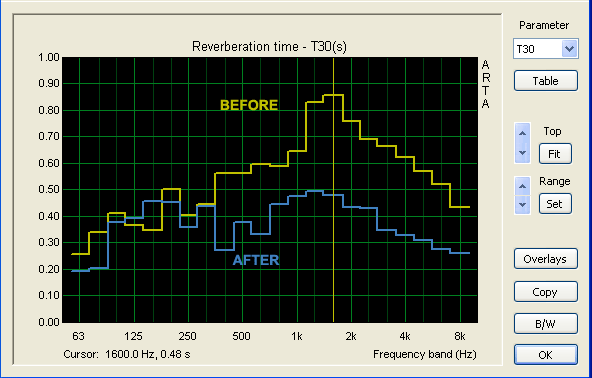
This tells a story of why I believe that certain people go for diffusion panels (most of which are only effective around 500-1000 Hz and higher frequencies). Since I've not had that problem in my room that I can recall, this plot by Pano gives me a glimpse of what is occurring. I would hazard a guess that directivity of loudspeakers above 500-1000 Hz (or rather, the lack thereof) is the root cause.
Why would I say that? Well, as a sideline, I volunteer to help others via emailing me their in-room REW measurement files so I can help them to dial-in their loudspeakers using DSP crossovers, and I get to see their RT room measurements at the same time. Thus far, I've helped in over two dozen installations that use (mostly) K-402-based loudspeakers, and have not seen this big rise in HF reverberation time in any of those REW measurement files.
Perhaps this observation might fuel conversations about controlled directivity/frequency and room reverberation times. I now observe that almost all the instances where someone is adding diffusion panels to their rooms--they also are using small-mouth horns (mostly on the K-forum where all the loudspeakers have HF horns). [When I say small, I'm talking about those loudspeakers whose minimum horn mouth dimensions (typically vertically) are about 5.5 inches (14 cm) or smaller.]
Maybe this is something that the "big horn crowd" avoids typically because of the dimensions of the horn mouths controlling their polars to lower frequencies than 1 kHz. I see a some other people having to use a lot of diffusion panels around the nearfield of their loudspeakers. This typically brings down reverberation times in the 1 kHz+ band.
I was under the impression that RT values were not really dependent on loudspeaker directivity. Apparently, this is not correct. (Comments welcome.)
A question for Pano: can you remember the HF horn/radiator that you used for your measurement above, and approximately where you placed the microphone relative to the loudspeakers in--room?
Chris
Those were made with both speakers playing, mic in the center of the room. The speakers were Altec VOTT A5 with the 1005 multicell horns + Fane bullet tweeters. Crossovers at about 700Hz and 7kHz. Speakers near room corners, toed in toward center. Directivity is pretty well controlled down to 300Hz.
Here are my living room and HT room measurements. The sound is very different in these rooms!
Living room is 3,5x6x6m with tilted ceiling and large openings to kitchen and corridor. Gypsum board walls. Nothing done for acoustics except normal furniture and one small carpet under the table. Measurement with a dipole and monopole speaker in same location.
HT room is 3x4x2,5m even ceiling with air space, lots of bookshelves on two walls, sofa. Gypsum board walls except concrete behind the bookshelf. Small carpet.
Living room is 3,5x6x6m with tilted ceiling and large openings to kitchen and corridor. Gypsum board walls. Nothing done for acoustics except normal furniture and one small carpet under the table. Measurement with a dipole and monopole speaker in same location.
HT room is 3x4x2,5m even ceiling with air space, lots of bookshelves on two walls, sofa. Gypsum board walls except concrete behind the bookshelf. Small carpet.
Attachments
For comparison, here is AINOgradient in a hotel room with concrete nude walls. Trapezoid area 2-4x5x2,5m. It still sounded quite good! I guess my brains adapted quickly. And so for others too, "best sound at event"award!
Attachments
I finally got around to testing my still unfurnished living room (which sounds awful) to have a starting point against which to measure future progress. Used the wonderful REW. The RT60 is around 3.8s at 1kHz and my target is more like 0.3s. Speech is difficult to follow, music sounds cluttered and that lingering 1kHz region is unpleasant. I have my work cut out for me 
- Home
- General Interest
- Room Acoustics & Mods
- RT60 and your listening room

